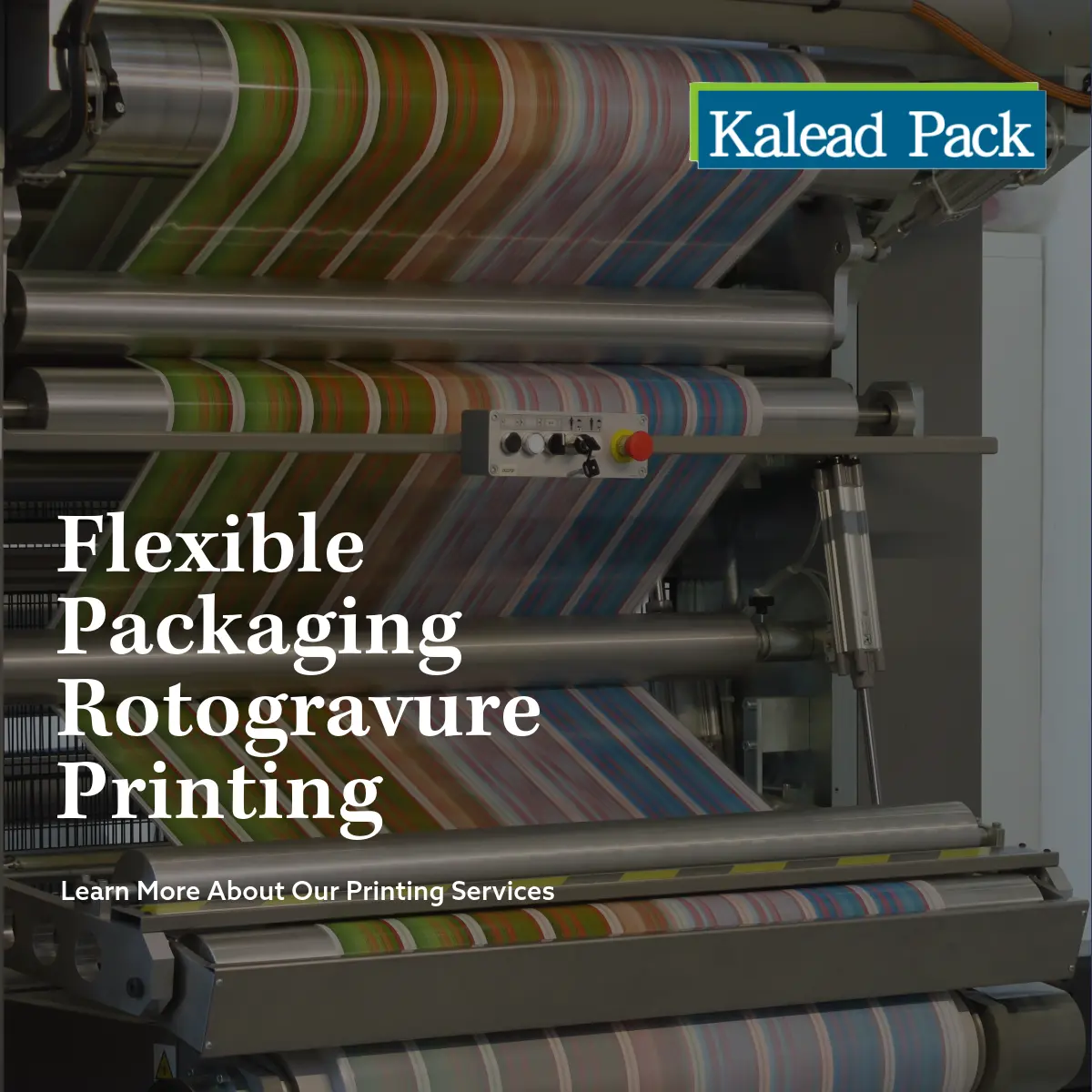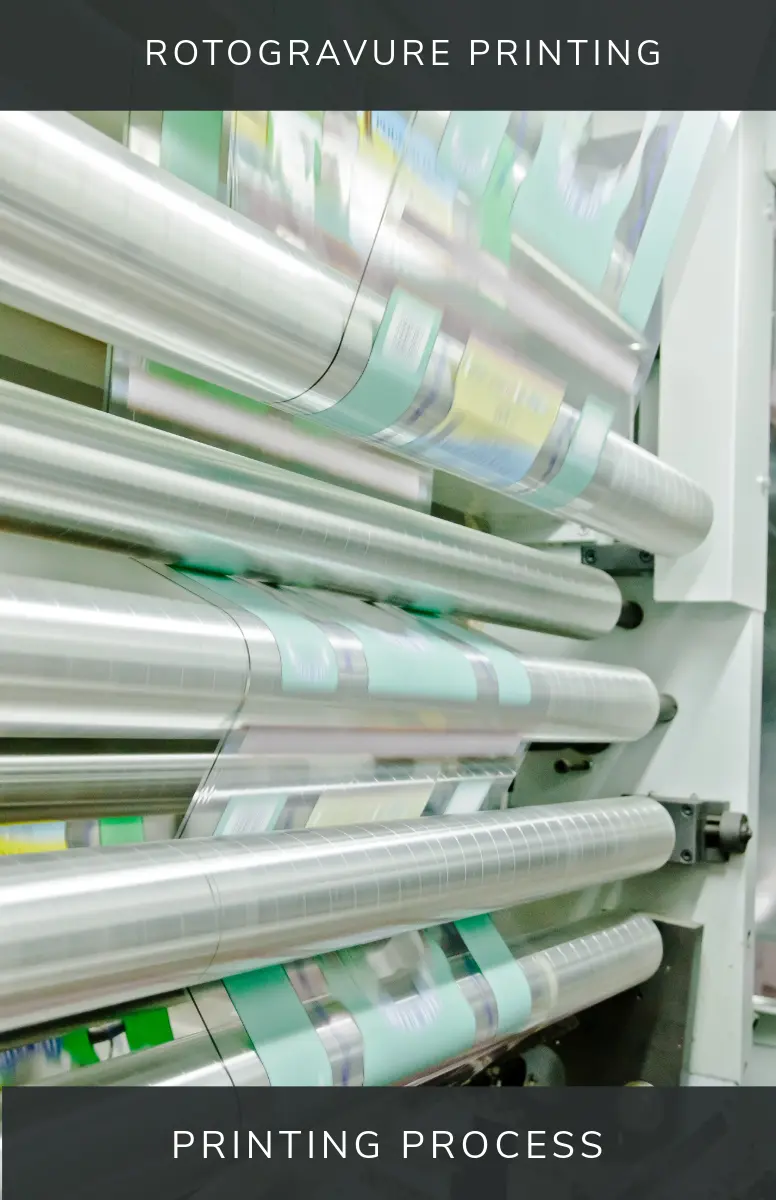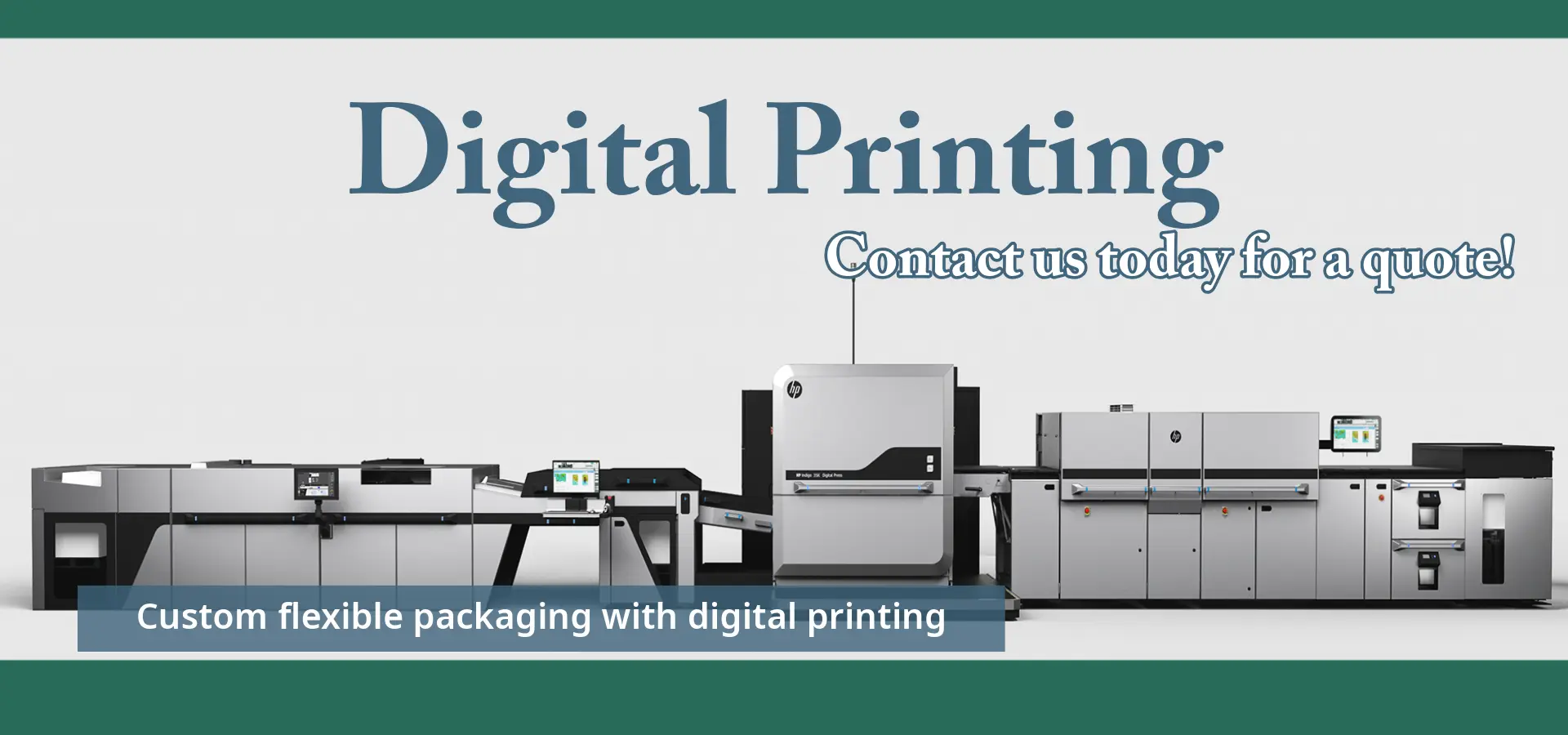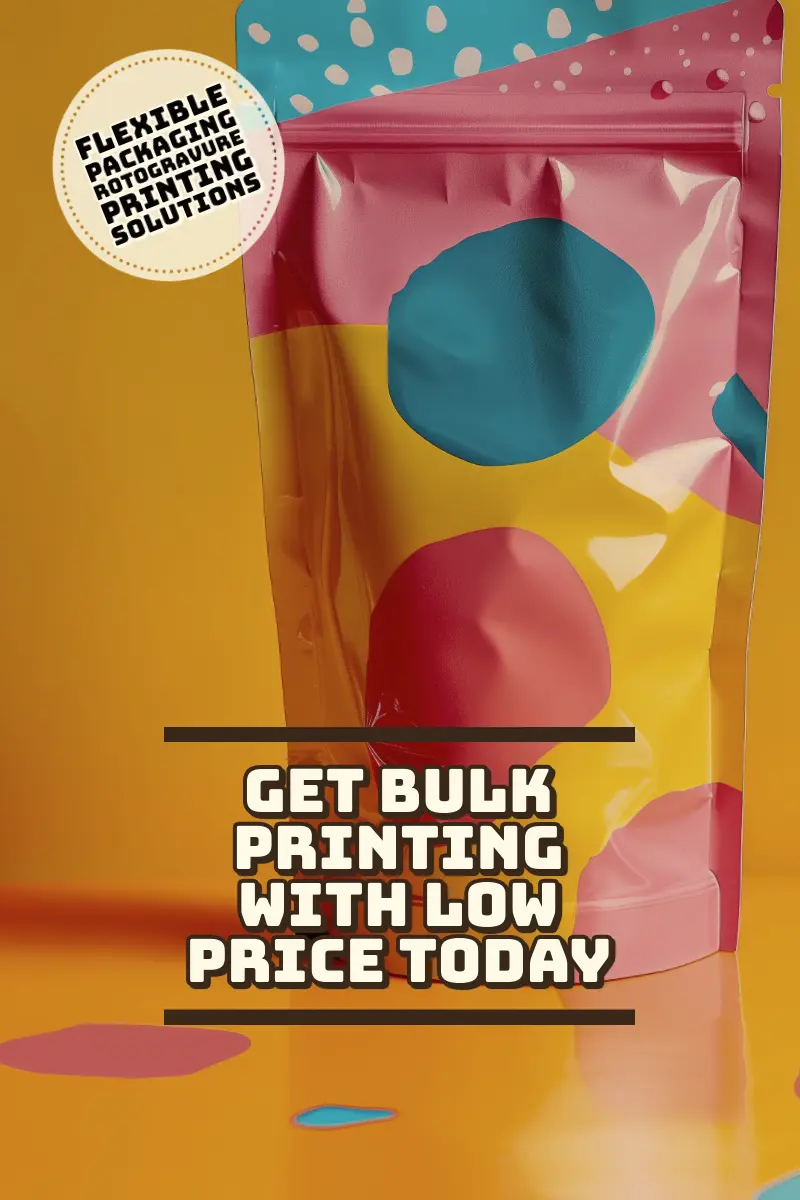로토그라비어 인쇄
Flexible packaging rotogravure printing remains the top choice for large-scale custom packaging. This well-established traditional printing technology provides high-quality image reproduction, making it ideal for various flexible packaging materials.
What Is Flexible Packaging Rotogravure Printing?
Flexible packaging rotogravure printing is an effective method to print images and text on plastic, foil, and paper. This process involves engraving the image onto a cylinder, which transfers the ink onto the packaging material. The cylinder contains tiny cells that hold the ink, and it transfers the ink to the material as it rotates.
One of the main benefits of rotogravure printing is its ability to produce high-quality, vivid images on packaging surface. This is perfect for packaging that needs to be eye-catching and detailed, like food, medicine, and other consumer products.
(Many food or non-food manufacturers use this printing method to make detailed designs on bulk packaging bags.)
The process starts with engraving the cylinder with the desired image, using either a laser or a diamond tool. The operator then mounts the cylinder onto the printing press, where it picks up ink from an ink fountain. A doctor blade removes excess ink, leaving the ink in the engraved cells. As the material passes through the press, it contacts the inked cylinder, transferring the image onto the material.
Rotogravure printing is efficient and fast, making it a cost-effective choice for large-scale production. It offers excellent color consistency and uses various inks and materials, making it suitable for different packaging needs.


Rotogravure Printing Process
1. Cylinder Engraving
The rotogravure printing process begins with cylinder engraving. A copper-plated steel cylinder gets engraved with tiny cells. Each cell holds ink.
2. Ink Application
Subsequently, the cylinder spins within an ink reservoir.. The cells fill with ink. A doctor blade scrapes off excess ink from the surface. Only the cells contain ink.
3. Printing
The cylinder then contacts the substrate, which could be paper or plastic film. The ink transfers from the cells to the substrate. This step ensures precise and consistent prints.
4. Drying Process
After printing, the material passes through drying ovens. These ovens evaporate solvents from the ink. This step is crucial to prevent smudging.
5. Material Rewinding
Finally, the printed material gets rewound onto a roll. This makes it ready for further processing or packaging. Rewinding ensures that the print remains intact.
6. Slitting
The slitting process begins with mounting the printed roll material onto the slitting machine. The machine uses rotary blades or laser cutting technology to cut the wide roll into strips of the desired width.
Advantages of Rotogravure Printing
High-Quality Image
Rotogravure printing offers excellent image quality. The process can produce highly detailed images with sharp lines and vivid colors. This makes it ideal for packaging that needs to stand out on shelves. Colors remain consistent across large print runs.
Flexible Substrate Printing
Rotogravure prints on multiple substrates. It works well with thin films, aluminum foil, and paper. This flexibility allows businesses to choose the best material for their products. For example, snack packaging often uses thin film for their durability and lightweight properties.
Cost-Effectiveness
Rotogravure is efficient for long-run printing jobs. The initial cost of creating engraved cylinders is high.
However, these cylinders last a long time without degrading. This leads to lower costs for large volume orders. Companies save money when producing millions of identical packages.
Cost Benefits
Rotogravure has significant cost benefits. Although setup costs are high, per-unit costs decrease with larger quantities. This makes it a cost-effective choice for products requiring mass production. Brands benefit from lower overall expenses while maintaining high-quality prints.
Rotogravure Printing for Large Production Runs
- Rotogravure printing may be an excellent option for brands looking to reduce per unit costs, especially for production runs of 10,000 units or more.
- It is a more durable and fade resistant printing method than 디지털 프린팅.
- 정확한 색상을 위해 팬톤 컬러 매칭이 가능합니다.
- 다양한 파우치 마감 처리 및 효과 선택이 가능합니다.
- 인쇄 작업 간 색상 일관성이 우수합니다.
- 구리 인쇄판을 사용하며, 각 색상별로 한 개씩 제작되어 수백만 회의 인쇄에 걸쳐 재사용할 수 있습니다.
- 인쇄판 비용은 일회성이며, 첫 번째 인쇄 이후에도 비용 절감 효과가 큽니다.
- 포뮬러 정보 변경 시 개별 인쇄판을 교체하여 디자인을 업데이트할 수 있습니다.
그라비어 인쇄 vs 디지털 프린팅
유연한 포장재 인쇄에는 2가지 일반적인 인쇄 방식이 있습니다. 주요 내용은 다음과 같습니다:
그라비어 인쇄:
- 대량 생산, 고품질, 일관된 인쇄 프로젝트에 최적화되었습니다.
- 식품 및 제약 산업과 같이 정교하고 생동감 있는 포장이 필요한 업종에 이상적입니다.
디지털 프린팅:
- 소량에서 중량 생산 및 맞춤형 프로젝트에 최적화되었습니다.
- 마케팅 자료 및 맞춤형 포장과 같이 빠른 납기와 개인화된 인쇄가 필요한 기업에 이상적입니다.

디지털 프린팅과 그라비어 인쇄 비교
| 특징 | 로토그라비어 인쇄 | 디지털 프린팅 |
|---|---|---|
| 기술 | 조각된 실린더 사용 | 디지털 파일 및 잉크젯/레이저 사용 |
| 설정 시간 | 긴 설정 시간 | 짧은 설정 시간 |
| 비용 효율성 | 대량 생산 시 비용 효율적 | 소량 생산 시 비용 효율적 |
| 인쇄 품질 | 고품질의 일관된 인쇄물 | 고품질이지만 변동 가능성 있음 |
| 색상 범위 | 우수한 색상 재현력 | 좋은 색상 범위 |
| 작업 완료 시간 | 설정 및 생산 시간이 더 오래 소요됨 | 빠른 납기 시간 |
| 유연성 | 유연성 낮음, 반복 작업에 적합 | 유연성 높음, 디자인 변경 용이 |
| 초기 비용 | 실린더 조각으로 인한 높은 초기 비용 | 낮은 초기 비용 |
| 가변 데이터 인쇄 | 부적합 | 가변 데이터 인쇄에 이상적 |
| 환경 영향 | 높은 폐기물 및 화학 물질 사용 | 낮은 폐기물, 더욱 친환경적 |
| 인쇄물의 내구성 | 최대 3년까지 매우 내구성이 강하고 오래 지속됨 | 내구성이 있지만 시간이 지나면 색이 바랄 수 있음 |
자주 묻는 질문
로토그라비어 인쇄 공정은 조각된 실린더를 사용하여 잉크를 기재에 전달합니다. 실린더가 잉크 트레이에서 회전하며 조각된 홈에 잉크를 채운 후 재료에 전달합니다.
로토그라비어 인쇄는 고품질과 정밀한 이미지, 효율성 및 속도를 제공합니다. 또한 내구성과 빠른 생산 능력으로 대량 인쇄 시 비용 효율적입니다.
예, 로토그라비어 인쇄는 대량 생산 시 비용 효율적입니다초기 설정 비용은 비쌀 수 있지만, 장기적으로 대규모 생산 시 비용을 절감합니다.
예, KaleadPack은 무료 샘플을 제공하며 전 세계 배송을 지원합니다. 언제든지 문의해 주세요. 저희는 파우치 백, 필름 인쇄, 포장 기계를 포함한 원스톱 포장 솔루션을 제공합니다.

